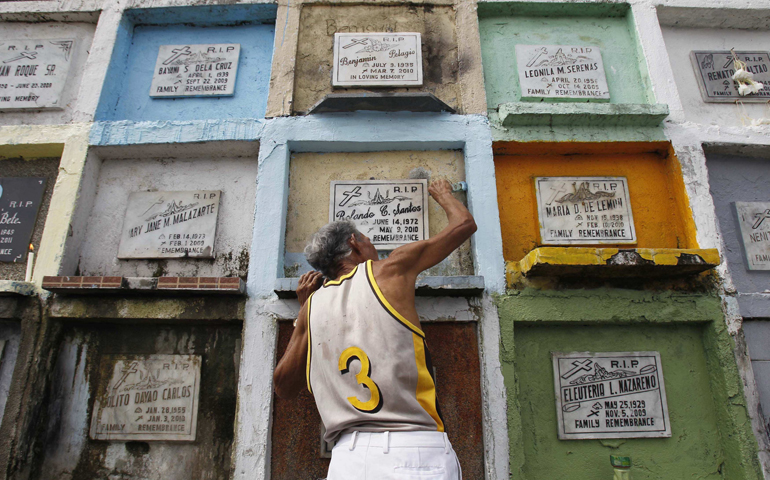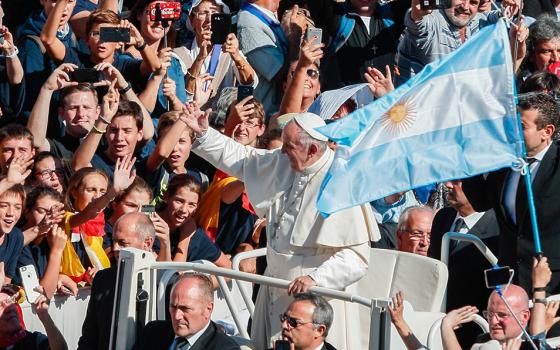
A man applies paint on his relative's tomb at a public cemetery Oct. 31, 2012, in Manila in preparation for All Saints' Day Nov. 1 and All Souls' Day Nov. 2. (CNS/Reuters/Romeo Ranoco)
During the last week of October, the main entrance to Manila North Cemetery looked like a small-town fiesta.
The area was draped with pale blue streamers forming a canopy above the road leading to the burial grounds. White and yellow dominated the dozens of flower and candle stands that lined the road, staffed sometimes by entire families, including children putting together flower arrangements.
Many vendors offered junk food and soda to the steady stream of visitors walking in and out of the cemetery.
On Wednesday, a number of visitors dropped in carrying cans of paint. Others had coarse, stiff brooms tucked under their arms.
Jomart Congreso and a companion were laden with bags of paint as they walked briskly toward their family's gravesite.
"It's for our grandparents, aunts and uncles," Congreso said. "We have a lot of relatives (who've died) so we have to paint five gravestones."
He said the paint job would take about five hours, then they would spend more time tidying up around the graves. By the end of the day, everything would be ready for when the entire family returned Friday, locally known as "Undas."
"We'll pack some meals and then pray," the 30-year-old told Catholic News Service. "We'll pray so that their souls are at peace and they have quiet."
In the Philippines, the Day of the Dead usually is celebrated Nov. 1, All Saints' Day. This is when people visit their loved ones' graves bearing food, flowers and candles and sometimes music -- when it's allowed at the cemetery.
The visits are often festive and become family reunions of sorts, and they can last into the night or even through the next day. Some families camp out and stay through All Souls' Day, Nov. 2. If people cannot make it to their loved ones' graves Nov. 1, they go the following day. The idea is for family and relatives to commune with their loved ones during these two Christian holy days that commemorate the dead.
In the Philippines, putting a fresh coat of paint on a gravesite is one of the most common ways to honor the family's dead.
Along one of the side arteries of the Manila North Cemetery, Yolanda de la Cruz and her family paint her father's tomb in a tiny gated gravesite. Their choice of paint this year stands out among the pastels and whites being applied at other markers.
"His grandchildren picked the color violet," de la Cruz said, pointing to her son and daughter who were helping clean up while their father, a painter by profession, touched up the grave. "Last year it was sky blue ... that was my father's favorite color."
De la Cruz, 54, said once the rest of the family arrives Friday morning, there will be food and companionship "like a fiesta" all day long and through the evening, because it's what her father, who died of a heart attack three years ago, liked. Also, she added, "He loved to dance."
The de la Cruzes came from Cavite, a province immediately south of the metro area. Others like Mariflor Mercado also traveled to the Manila cemetery from nearby provinces.
Mercado and her two adult children came from Valenzuela City and Bulacan, just north of Metro Manila.
"It's just a quick visit," she said. "We'll just light some candles and pray for my father and grandfather."
Then, Mercado told CNS, they will move on to another cemetery about two miles away, where her mother and that side of the family are buried. The trio decided to go two days ahead of "Undas" to beat the crowds, which they said would be practically unbearable Nov. 1.
Cemetery-hopping is also pretty common at this time of year.
At the Araneta Bus Terminal about 10 miles east of the cemetery, dozens of buses filled up with hundreds of people on their way to the far-flung provinces for the long weekend to commemorate the dead.
Analiza Villanueva sat at the curb near a bus that would take her as far southeast as it could go. Then she planned to transfer to a ferry that would eventually dock in an island province on the eastern side of the central Philippines.
Villanueva said this year, her family had the money to travel, so she was on a multi-cemetery route, first traveling to Boracay, a tiny island province south of Manila, where her father is buried, then visiting her mother and brother in two Manila-area cemeteries, and eventually ending the trip in Masbate, where her grandparents have been laid to rest.
"They're all spread apart," said Villanueva. It's about 48 hours of traveling, but she said the trips are worth it, especially the visit to the province, which is like a family reunion. "It's a nice way to celebrate the lives of the dead and to be able to return to family after so many years away."
